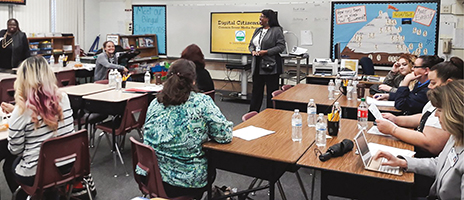Practices for Districtwide Digital Citizenship
Type:
Article
Topics:
College- Career- and Life-Readiness,
School Administrator Magazine,
Technology & AI
April 01, 2018

Increasingly, the misuse and abuse of technology in our schools are moving far beyond the parameters of school districts’ acceptable use policies. This trend, combined with issues such as student privacy and fake news, demands an increased emphasis on digital citizenship.
Concept Defined
What does digital citizenship mean? Digital citizenship is about thinking critically, being safe and acting responsibly in an interconnected digital world.In his book Digital Citizenship in Schools, Mike Ribble, a former secondary school administrator, identifies three main categories for digital citizenship: respect (etiquette, access and law), educate (communication, literacy and commerce) and protect (rights and responsibilities, safety and security, and health and wellness).
School districts can use these categories as the foundation for promoting digital citizenship.
Suggested Practices
Here are some suggestions for promoting digital citizenship across a district.»Establish a shared vision to prioritize digital citizenship.
During the first administrators’ meeting of 2015-16, the chief academic officer in Los Angeles Unified School District announced a districtwide focus on digital citizenship, which led to website resources for school use and a student panel during Digital Citizenship Week. This emphasis from senior leadership set a tone for action by individual campuses.
» Make digital citizenship a part of the district culture.
With an increasing number of schools introducing one-to-one technology initiatives each year, the Fullerton, Calif., School District took a whole-community approach to preparing staff and students to use digital media responsibly. The district uses Common Sense Education’s digital citizenship curriculum to promote skills related to internet safety, personal privacy and online reputations, and copyright restrictions. Common Sense-certified educators help schools regarding implementation.
When a middle school in Cave Creek, Ariz., Unified School District was plagued with a rash of student sexting and cyberbullying, the school piloted a new Digital Citizen Academy program alongside the program’s founder, psychologist Lisa Strohman. The district’s curriculum teaches safe internet practices and promotes tools and lessons to prevent cyberbullying, sexting and digital cheating. One year after the pilot was started, the school’s principal reported a 70 percent reduction in disciplinary referrals relating to technology misuse.
» Build capacity by involving stakeholders.
Recognizing the importance of involving all stakeholders to promote digital citizenship, many districts provide training for parents. California’s Santa Ana Unified School District sponsors a Digital Citizenship Academy for parents. To build capacity, academy partici-pants receive materials to share with other parents in the community.
» Provide incentives for participation.
The technology services department at San Juan Unified School District in Sacramento, Calif., offers teachers incentives for participating in monthly professional development activities around digital citizenship. Teachers who participate qualify their classes for student digital citizenship competitions and field trips each semester.
Author
Devery Rodgers recommends these informational resources relating to digital citizenship.
» Common Sense Education’s K-12 digital citizenship curriculum and CIPA-compliance toolkit including districtwide implementation plans and an anti-cyberbullying toolkit with a response flowchart for administrators
» Digital Citizenship in Schools: Nine Elements All Students Should Know by Mike Ribble, ISTE
» International Society for Technology in Education’s digital citizenship resources
Advertisement
Advertisement
Advertisement
Advertisement



